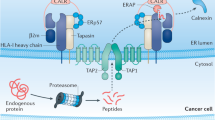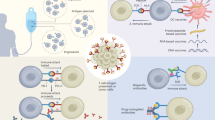Abstract
Cancer cells differ from normal cells in their response to chemotherapy. We exploited this dissimilarity by identifying and targeting tumor-specific, cell-surface proteins whose expression is induced by the chemotherapeutic irinotecan (CPT-11; Camptosar). A cytotoxin-armed antibody reactive with one of these drug-induced surface proteins, the LY6D/E48 antigen, originally identified as the target of a monoclonal antibody reactive with squamous cell carcinomas, caused complete regression of colorectal tumor xenografts in mice treated with CPT-11, whereas either agent alone was less effective. These results suggest that a positive therapeutic index may be generated for other drug combinations by immunotherapeutic targeting of chemotherapy-induced antigens.
This is a preview of subscription content, access via your institution
Access options
Subscribe to this journal
Receive 12 print issues and online access
$209.00 per year
only $17.42 per issue
Buy this article
- Purchase on Springer Link
- Instant access to full article PDF
Prices may be subject to local taxes which are calculated during checkout




Similar content being viewed by others
References
Tice, D.A. et al. Synergistic induction of tumor antigens by Wnt-1 signaling and retinoic acid revealed by gene expression profiling. J. Biol. Chem. 277, 14329–14335 (2002).
Mehta, K., Ocanas, L., Malavasi, F., Marks, J.W. & Rosenblum, M.G. Retinoic acid-induced CD38 antigen as a target for immunotoxin-mediated killing of leukemia cells. Mol. Cancer Ther. 3, 345–352 (2004).
Qin, L.F., Lee, T.K. & Ng, I.O. Gene expression profiling by cDNA array in human hepatoma cell line in response to cisplatin treatment. Life Sci. 70, 1677–1690 (2002).
Li, Y. et al. Gene expression profiling revealed novel mechanism of action of Taxotere and Furtulon in prostate cancer cells. BMC Cancer 5, 7 (2005).
Whiteside, M.A., Chen, D.T., Desmond, R.A., Abdulkadir, S.A. & Johanning, G.L. A novel time-course cDNA microarray analysis method identifies genes associated with the development of cisplatin resistance. Oncogene 23, 744–752 (2004).
Chang, B.D. et al. Molecular determinants of terminal growth arrest induced in tumor cells by a chemotherapeutic agent. Proc. Natl. Acad. Sci. USA 99, 389–394 (2002).
Taxman, D.J., MacKeigan, J.P., Clements, C., Bergstralh, D.T. & Ting, J.P. Transcriptional profiling of targets for combination therapy of lung carcinoma with paclitaxel and mitogen-activated protein/extracellular signal-regulated kinase kinase inhibitor. Cancer Res. 63, 5095–5104 (2003).
Zhou, Y. et al. Transcriptional regulation of mitotic genes by camptothecin-induced DNA damage: microarray analysis of dose- and time-dependent effects. Cancer Res. 62, 1688–1695 (2002).
Kudoh, K. et al. Monitoring the expression profiles of doxorubicin-induced and doxorubicin-resistant cancer cells by cDNA microarray. Cancer Res. 60, 4161–4166 (2000).
Macdonald, J.S. Clinical overview: adjuvant therapy of gastrointestinal cancer. Cancer Chemother. Pharmacol. 54. (Suppl 1), S4–11 (2004).
Brakenhoff, R.H. et al. The human E48 antigen, highly homologous to the murine Ly-6 antigen ThB, is a GPI-anchored molecule apparently involved in keratinocyte cell-cell adhesion. J. Cell Biol. 129, 1677–1689 (1995).
de Bree, R. et al. Selection of monoclonal antibody E48 IgG or U36 IgG for adjuvant radioimmunotherapy in head and neck cancer patients. Br. J. Cancer 75, 1049–1060 (1997).
de Bree, R., Roos, J.C., Verel, I., van Dongen, G.A. & Snow, G.B. Radioimmunodiagnosis of lymph node metastases in head and neck cancer. Oral Dis. 9, 241–248 (2003).
Nieuwenhuis, E.J. et al. Assessment and clinical significance of micrometastases in lymph nodes of head and neck cancer patients detected by E48 (Ly-6D) quantitative reverse transcription-polymerase chain reaction. Lab. Invest. 83, 1233–1240 (2003).
Oosterhoff, D. et al. Gene-directed enzyme prodrug therapy for osteosarcoma: sensitization to CPT-11 in vitro and in vivo by adenoviral delivery of a gene encoding secreted carboxylesterase-2. Mol. Cancer Ther. 2, 765–771 (2003).
Bevins, C.L. The Paneth cell and the innate immune response. Curr. Opin. Gastroenterol. 20, 572–580 (2004).
Doronina, S.O. et al. Development of potent monoclonal antibody auristatin conjugates for cancer therapy. Nat. Biotechnol. 21, 778–784 (2003).
Brakenhoff, R.H., van Dijk, M., Rood-Knippels, E.M. & Snow, G.B. A gain of novel tissue specificity in the human Ly-6 gene E48. J. Immunol. 159, 4879–4886 (1997).
Quak, J.J. et al. A 22-kd surface antigen detected by monoclonal antibody E 48 is exclusively expressed in stratified squamous and transitional epithelia. Am. J. Pathol. 136, 191–197 (1990).
Eshel, R. et al. The GPI-linked Ly-6 antigen E48 regulates expression levels of the FX enzyme and of E-selectin ligands on head and neck squamous carcinoma cells. J. Biol. Chem. 275, 12833–12840 (2000).
Eshel, R. et al. Human Ly-6 antigen E48 (Ly-6D) regulates important interaction parameters between endothelial cells and head-and-neck squamous carcinoma cells. Int. J. Cancer 98, 803–810 (2002).
Wodicka, L., Dong, H., Mittmann, M., Ho, M.H. & Lockhart, D.J. Genome-wide expression monitoring in Saccharomyces cerevisiae. Nat. Biotechnol. 15, 1359–1367 (1997).
Acknowledgements
We thank Peter Senter and Damon Meyer for preparation of drug-conjugated antibodies, Tracey McKenna, Angela Lamb, JoAnne Hongo and Kurt Schroeder for generation and purification of monoclonal antibodies to LY6D/E48 and technical assistance.
Author information
Authors and Affiliations
Corresponding author
Ethics declarations
Competing interests
The authors declare no competing financial interests.
Supplementary information
Supplementary Table 1
Transcripts induced in Colo205 tumor xenografts exposed to CPT-11. (PDF 51 kb)
Supplementary Table 2
Transcripts induced in the intestine of mice exposed to CPT-11. (PDF 46 kb)
Rights and permissions
About this article
Cite this article
Rubinfeld, B., Upadhyay, A., Clark, S. et al. Identification and immunotherapeutic targeting of antigens induced by chemotherapy. Nat Biotechnol 24, 205–209 (2006). https://doi.org/10.1038/nbt1185
Received:
Accepted:
Published:
Issue Date:
DOI: https://doi.org/10.1038/nbt1185
This article is cited by
-
A Dynamic Covalent Bonding-based Nanoplatform for Intracellular Co-Delivery of Protein Drugs and Chemotherapeutics with Enhanced Anti-Cancer Effect
Chinese Journal of Polymer Science (2024)
-
Lymphocyte antigen 6 superfamily member D is a marker of urothelial and squamous differentiation: implications for risk stratification of bladder cancer
Biomarker Research (2020)
-
Sensitivity of CD3/CD28-stimulated versus non-stimulated lymphocytes to ionizing radiation and genotoxic anticancer drugs: key role of ATM in the differential radiation response
Cell Death & Disease (2018)
-
Adoptive T-cell therapy improves treatment of canine non–Hodgkin lymphoma post chemotherapy
Scientific Reports (2012)
-
Designer combination therapy for cancer
Nature Biotechnology (2006)



